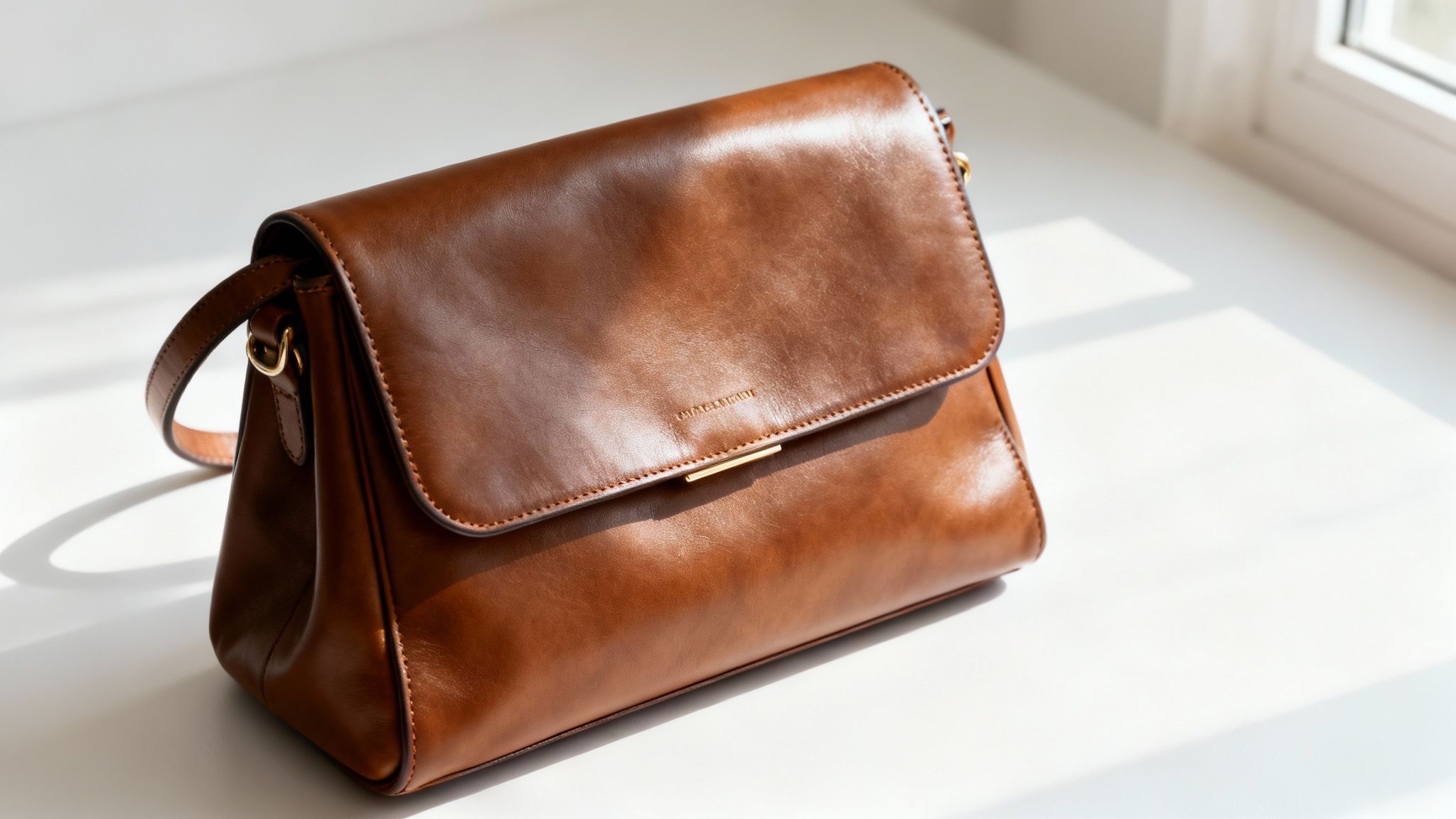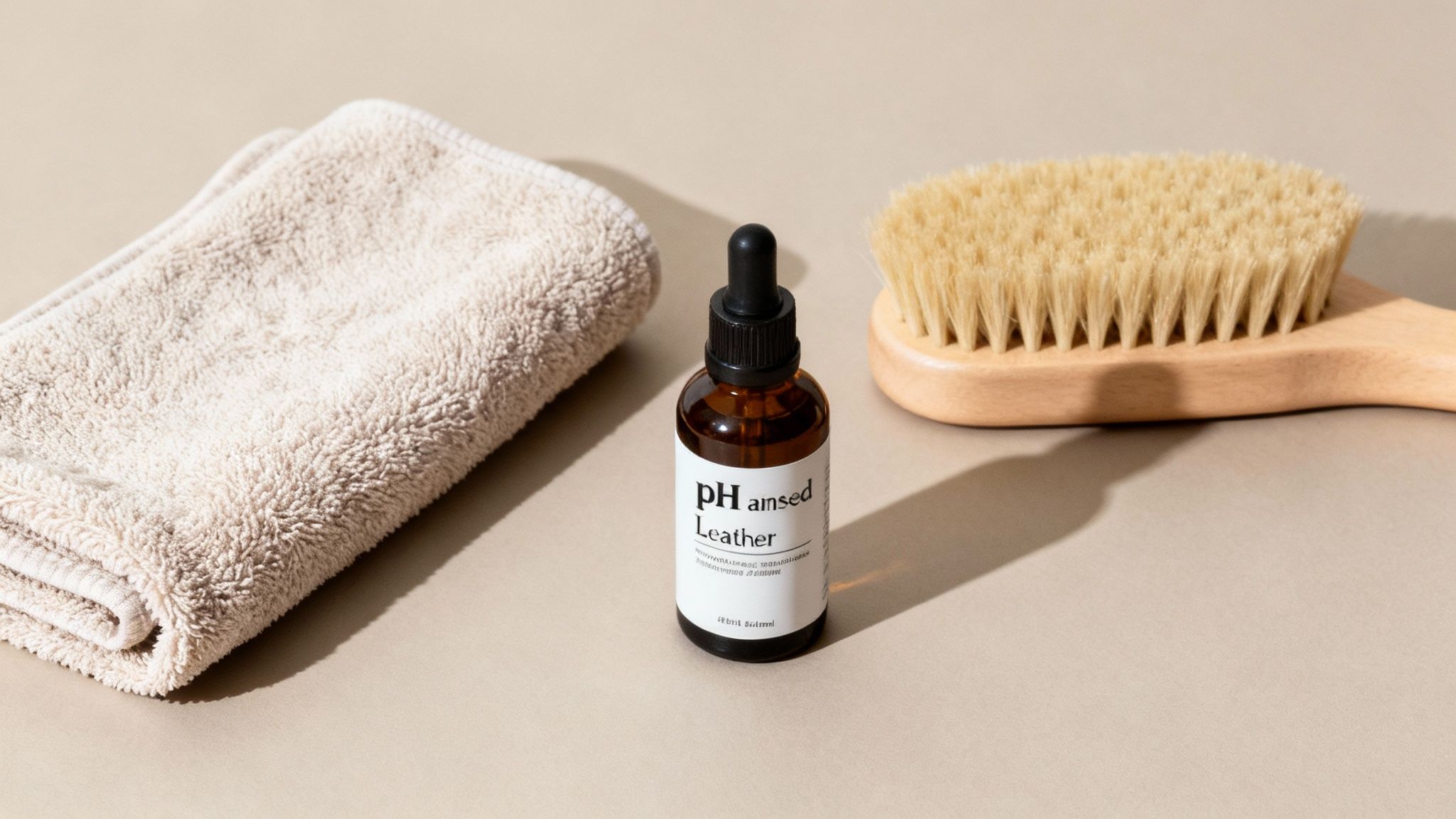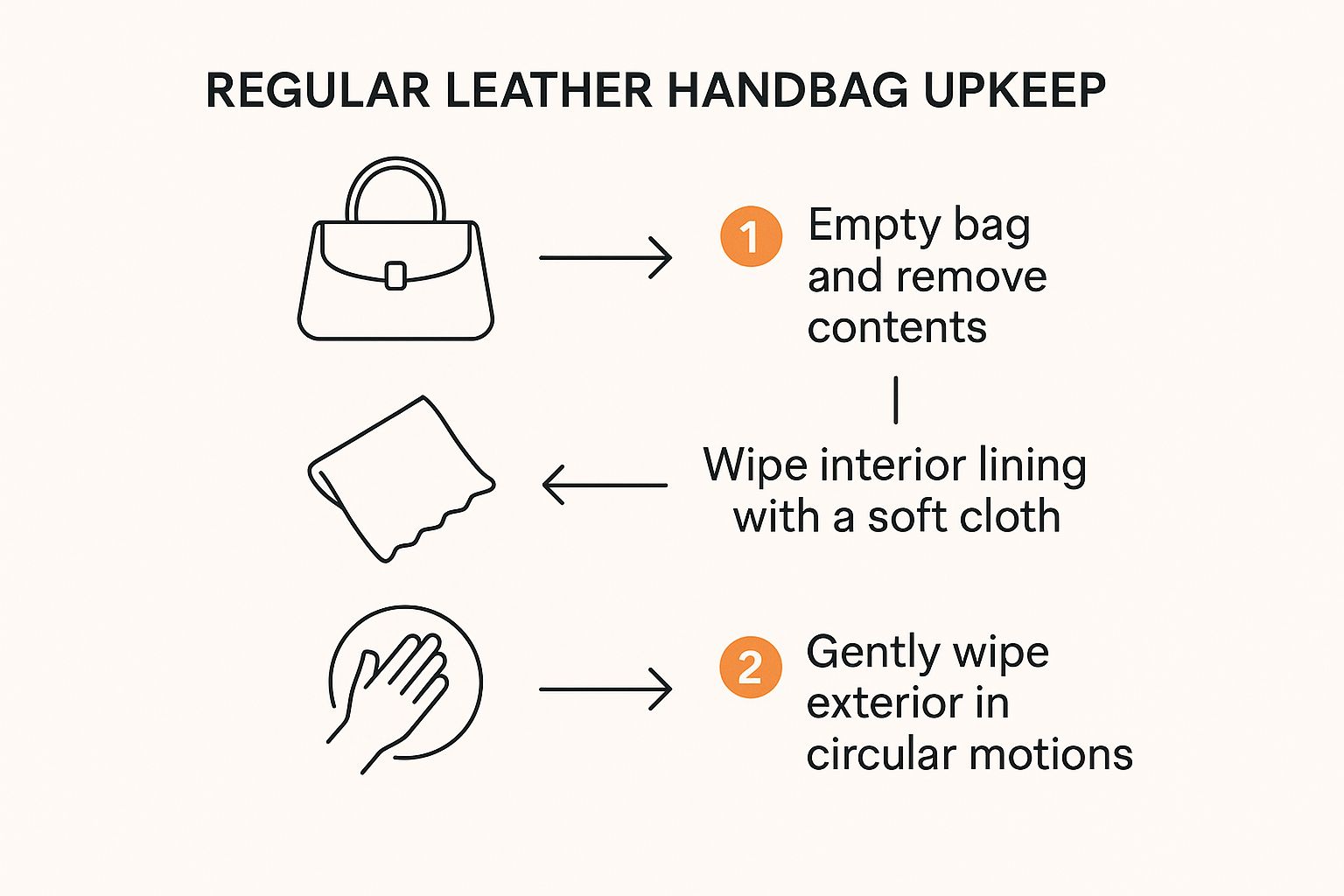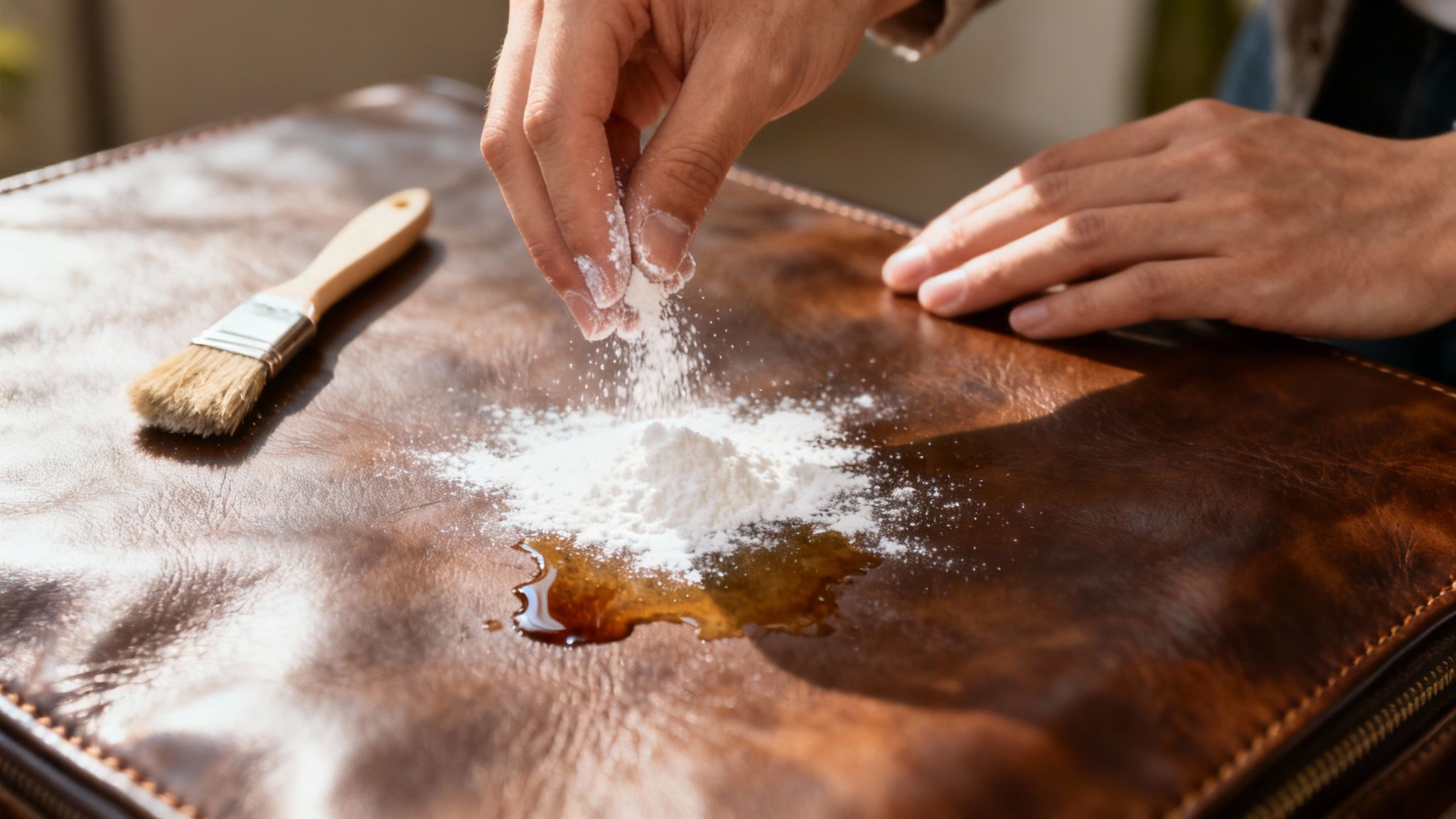How to Clean Leather Handbags Like a Pro

When you know how to clean leather handbags, the whole process is surprisingly simple. It really just comes down to two key things: gently wiping the surface with a pH-neutral leather cleaner and following up with a good conditioner to restore that lovely moisture.
This quick routine is your best defense against dirt setting in, keeping the material supple and preserving your bag’s beauty and value for years to come.
Why Your Leather Handbag Deserves Better Care
A quality leather handbag is so much more than a place to stash your keys and phone; it’s a real investment piece and a core part of your personal style. But like any investment, it needs a bit of maintenance to hold its value.
Daily use exposes it to everything—the natural oils from your hands, dust floating in the air, accidental coffee splashes, and general city grime. It all adds up.

Without proper care, all that buildup starts to degrade the leather’s delicate finish. Over time, the material can get dry and thirsty, leading to those dreaded cracks, discoloration, and a dull, tired appearance. Learning how to properly clean your leather handbag isn’t a chore; think of it as a crucial act of preservation.
The Value of Consistent Maintenance
A little consistent care goes a long way in extending the life of your bag, ensuring it remains a staple in your wardrobe for the long haul. This approach is also wonderfully sustainable, shifting the focus from fast, disposable fashion toward cherishing the beautiful things we already own.
You can see this preference for longevity everywhere. The global market for repairing leather goods, which includes professional cleaning and restoration, was valued at a huge $2.5 billion in 2023 and is expected to climb to $4.1 billion by 2032. This trend really highlights how much consumers are choosing to maintain their high-value accessories rather than just replacing them. You can read more about this sustainable fashion trend and its impact on the market.
By dedicating just a few minutes every month to maintenance, you can stop minor issues before they become irreversible damage. This simple habit helps you avoid expensive professional repairs or the disappointment of having to retire a favorite bag way too soon.
Beyond Aesthetics: The Lasting Benefits
A well-maintained handbag doesn't just look better on your arm; it holds its value far better, too. Proper cleaning and conditioning preserve the leather's structural integrity, keeping the material from weakening over time. It’s like a little wellness routine for your most-loved accessory.
This guide will give you the confidence and know-how to care for your handbag like a pro. You'll quickly see that with the right techniques and a touch of consistency, you can protect your investment and keep your bag looking as stunning as the day you first fell in love with it.
Assembling Your Essential Cleaning Toolkit
Before you even touch your bag with a cloth, the first and most important step is gathering the right supplies. I can't stress this enough—reaching for a rough paper towel or a harsh kitchen soap can cause irreversible damage. Think scratches, discoloration, or a dry, brittle feel.
Building a dedicated kit isn't about being fussy; it's about protecting your investment.

The good news is that your basic toolkit doesn't need to be complicated or expensive. The goal is simply to have gentle, effective items on hand that are made specifically for leather's unique needs.
Here’s what you absolutely must have:
- Several soft, white microfiber cloths: White is key here because it prevents any accidental color transfer to your beautiful bag. Microfiber is a genius at lifting dirt without scratching the surface.
- A soft-bristled brush: This is a lifesaver for gently getting dirt out of seams, hardware crevices, and textured leathers. Look for one made with horsehair or a very soft synthetic bristle.
- A pH-balanced leather cleaner: Remember, leather is a skin. Just like our own skin, its pH level needs to be maintained. Standard household cleaners are almost always too alkaline or acidic, which will strip the leather’s natural oils right out.
- A quality leather conditioner: After cleaning, conditioning is non-negotiable. It’s what puts the moisture back in, keeping the leather supple and preventing it from drying out and cracking over time.
Choosing Your Cleaning Solution
Now, when it comes to the cleaner itself, you really have two main paths: professional products or carefully mixed DIY solutions. Each has its place, and knowing when to use which is the secret to a great result.
Commercial leather cleaners are formulated by experts and tested extensively to be safe and effective. They offer reliability and, honestly, a lot of peace of mind. On the other hand, some DIY options can work for minor upkeep if you're in a pinch.
Here’s a quick breakdown to help you decide what’s best for your situation.
Professional vs DIY Leather Cleaning Solutions
| Solution Type | Pros | Cons | Best For |
|---|---|---|---|
| Commercial Leather Cleaner | Formulated to be pH-balanced; tested for safety and effectiveness; often contains conditioning agents. | Can be more expensive; requires purchasing a specialty product. | Deep cleaning, stain removal, and routine care for high-value bags. |
| DIY (e.g., Water & Vinegar) | Inexpensive and uses common household items; good for quick, light cleanups. | Risk of drying out or discoloring leather if mixed improperly; not suitable for all leather types. | Light surface dirt on durable, finished leathers after a successful patch test. |
Whether you go pro or DIY, one rule is absolute.
The golden rule of leather care is to always test any cleaning product on a small, hidden spot first. Use an area inside a pocket or on the bottom of the bag, let it dry completely, and make sure there’s no discoloration before you go any further.
This simple precaution is the single best way to prevent a cleaning attempt from turning into a costly, heartbreaking mistake. With your toolkit assembled and tested, you're ready to tackle dirt and grime with total confidence.
Your Go-To Routine for Regular Upkeep
The real secret to a leather handbag that lasts a lifetime isn't some intense, once-a-year deep clean. It's all about the small, consistent habits that protect its beauty day in and day out. A simple upkeep routine every few weeks is your best defense against the buildup of oils, dust, and daily grime that can dull your bag’s finish.
Think of it as a quick refresh for your bag after a long week. After a few days of commuting on trains or tossing it in the car, a quick wipe-down stops surface particles from settling into the leather's grain. This simple act is the key to preventing long-term damage and keeping your bag looking pristine.
Start From the Inside Out
Before you even think about the leather exterior, always start by emptying your handbag completely. Take out absolutely everything—wallet, keys, stray receipts, and that rogue tube of lip balm you thought you lost.
Give the bag a good shake upside down over a trash can to dislodge any crumbs or debris that have made a home at the bottom.
If the lining can be pulled out, turn it inside out. If it’s fixed, just pull it out as far as it will go. Grab a soft, dry microfiber cloth or a lint roller to gently lift away any lingering dust from the fabric. For more stubborn interior issues, our guide on how to clean your handbag interior has some deeper cleaning tips.
Don't skip this step! A clean interior stops dirt from transferring onto your belongings and, eventually, back onto the outside of your beautiful bag.
This infographic breaks down the regular maintenance process into three simple parts.

As you can see, the process is incredibly straightforward: empty the bag, wipe the inside, and then gently clean the exterior. It's an easy routine to work into your schedule.
Mastering the Gentle Wipe-Down
Now, let's turn our attention to the exterior. For this part, your technique is just as important as the products you use.
Slightly dampen a clean, white microfiber cloth with a pH-balanced leather cleaner or a properly diluted DIY solution. The cloth should be damp, not wet—too much water can easily stain or damage the leather.
Gently wipe the entire surface of the bag with soft, circular motions. This helps lift dirt from the grain without being too harsh. Avoid scrubbing or applying heavy pressure, even on spots that look extra dirty. The goal here is a gentle refresh, not a deep scour.
Pro Tip: Pay extra attention to the parts of the bag that see the most action, like the handles, straps, and bottom corners. These areas are magnets for oils from your hands and dirt from the surfaces you set your bag on.
Once you’re done wiping, take a second, completely dry microfiber cloth and buff the entire bag. This step removes any remaining moisture and helps bring back the leather’s natural luster.
Let your bag air dry for at least one hour in a well-ventilated spot, far away from direct heat or sunlight, before you use it again. This little bit of patience is crucial for cleaning leather handbags effectively while preserving their quality for years to come.
Our Practical Guide to Removing Tough Stains
Let’s be honest—no matter how careful we are, life happens. A pen leaks in a meeting, or you get splashed with coffee on your morning commute. That sinking feeling when you look down at your favorite leather handbag is all too real. But don't panic! Many of those dreaded stains can be treated right at home, especially if you act fast.

The trick is to get to the stain as soon as you spot it. The longer something sits on the leather, the deeper it sinks into the pores, making it much tougher to get out later. Think of this guide as your go-to resource for those heart-stopping moments, with clear methods for the most common culprits.
The First and Most Crucial Step
Before you grab any cleaning solution, remember the golden rule of leather care: always spot-test first. Find a hidden area on your bag, maybe on the inside of a strap or a corner on the bottom, and apply just a tiny amount of your cleaning agent. Let it dry completely to make sure it doesn’t cause any discoloration or damage.
This simple five-minute check can save you from turning a small, fixable spot into a large, permanent problem. Patience is truly your best friend when you're learning how to clean leather handbags and deal with unexpected stains.
Taking this one small step protects your bag's integrity and gives you the confidence to treat the stain properly.
How to Tackle Oil and Grease Stains
Grease from food, makeup, or even hand lotion can leave a stubborn, dark mark. The key here is to absorb that oil as quickly as possible before it has a chance to set.
As soon as you notice a fresh grease stain, sprinkle a generous amount of cornstarch or talcum powder right on it. Don't try to rub it in. Just let the powder sit for several hours—or even overnight if you can. It acts like a little sponge, drawing the oil right out of the leather.
When the time is up, gently brush the powder away with a soft-bristled brush. You might need to repeat the process a couple of times for a particularly heavy stain. If you're dealing with a more stubborn mark, we have a variety of other techniques in our full guide on how to remove stains from leather.
Dealing with Ink and Pen Marks
An accidental pen mark is one of the most frequent handbag mishaps. For a fresh ink stain on finished leather, you might be surprised to find that a simple white eraser can do the trick. Just gently rub the mark, being careful not to scrub too hard.
If that doesn't work, isopropyl (rubbing) alcohol is another effective method:
- Dip the very tip of a cotton swab into rubbing alcohol.
- Carefully dab the swab directly onto the ink, trying to avoid the surrounding leather as much as possible.
- Use a clean, dry cloth to gently blot the area. You should start to see the ink transfer from your bag to the cloth.
- Once the stain is gone, let the spot dry completely. Alcohol is very drying, so it's a good idea to follow up by applying a small amount of leather conditioner to that spot.
Handling Coffee, Tea, and Water Stains
Dark liquid spills like coffee and tea can leave behind those awful, tell-tale rings. The goal is to lift the stain without making it spread. Start by immediately blotting the fresh spill with a clean, dry cloth to soak up as much liquid as you can.
Next, create a very mild cleaning solution by mixing a few drops of a pH-neutral soap or a specialized leather cleaner with distilled water. Dampen a soft cloth with this solution—make sure it’s just damp, not soaking wet—and gently blot the stain, working from the outside in. This technique helps keep the stain contained.
The desire for effective cleaning solutions is growing, with the leather cleaner market valued at around USD 800 million in 2025 and projected to hit USD 1.2 billion by 2033. This growth shows just how much people value preserving their premium leather goods, and for good reason
How to Condition and Protect Your Handbag
Simply cleaning your leather bag without conditioning it is like washing your hair but skipping the conditioner. Sure, you've removed the daily grime, but you've also stripped away the good stuff—the essential moisture that keeps it healthy.
Leather is a natural skin, and just like our own, its porous surface needs hydration to stay soft, flexible, and strong. Conditioning is the step that truly brings your bag back to life, replenishing the natural oils within the fibers to stop them from drying out and becoming brittle.
A well-conditioned bag not only feels incredibly supple but is also far less likely to develop heartbreaking cracks over time. Think of it as giving your favorite accessory a long, satisfying drink of water after a deep clean.
This growing awareness is why the global leather care products market is set to expand from USD 3.9 billion in 2024 to nearly USD 5.9 billion by 2034. It’s clear that people understand conditioning is non-negotiable for preserving the value and beauty of their leather goods. You can discover more insights about the leather care market and see just how much this industry is growing.
Applying Conditioner the Right Way
First things first: choose the right product. Always pick a conditioner specifically formulated for your bag's type of leather. Once you have the right one, your application technique is everything. The goal here is to nourish the leather, not drown it.
Put a small, dime-sized dollop of conditioner onto a clean microfiber cloth. Then, gently rub it into the leather using broad, circular motions. This approach guarantees a thin, even coat and helps the product sink deep into the pores where it’s needed most.
Never squeeze conditioner directly onto the leather itself. This is a fast track to creating a dark, concentrated spot that's nearly impossible to blend out. Using a cloth as your applicator gives you total control for a flawless finish.
After you've covered the entire bag, let it sit and work its magic for about 30 minutes to an hour. This gives the leather enough time to fully absorb all that moisture. Grab another clean, dry cloth and give the bag a final buff to wipe away any excess and bring back its gorgeous, natural sheen. For a more detailed guide, check out our complete post on how to care for leather bags.
Adding a Final Layer of Protection
You’re almost there! Your bag is clean and beautifully conditioned, but there’s one final step to truly safeguard your investment: a leather protector spray. This is like an invisible shield for your handbag, defending it against whatever the day throws your way.
A quality protector spray forms a breathable barrier over the leather's surface. This invisible armor repels water, which means no more panic during an unexpected rain shower. It also helps block future stains from spills or dirt, making your next cleanup a whole lot easier.
Applying it is simple. Just follow these quick steps for the best results:
- Hold the can about 6-8 inches away from your bag.
- Spray a light, even coat across the entire exterior.
- Let the bag air dry completely for at least a few hours (or whatever the product instructions recommend) before you take it out.
This final touch provides incredible peace of mind, letting you carry your cherished handbag with confidence. It’s a simple action that makes a world of difference in keeping it beautiful for years.
Common Questions on Leather Handbag Care
Even with a great guide, taking care of a beloved leather handbag can bring up some tricky, real-world questions. We see them all the time. Getting the right answers can be the difference between a beautifully preserved bag and a costly, heartbreaking mistake.
Let’s clear up the confusion and give you the confidence to care for your bag, no matter what life throws at it.
How Often Should I Clean My Leather Handbag?
This really comes down to one thing: how often you carry your bag. Think about it—a purse that’s your daily sidekick on the commute is going to face a lot more wear and tear than a clutch reserved for special nights out.
A good rule of thumb is to have a tiered schedule.
- For daily-use bags: Give it a quick, gentle wipe-down with a dry microfiber cloth every week or two. This simple step stops everyday dust and oils from building up.
- For all bags: Plan a deeper clean and conditioning session every 6 to 12 months. This is like a spa day for your bag, restoring moisture and keeping the leather supple.
- For special occasion bags: A simple wipe-down after you use it and before you put it away is usually all it needs.
Of course, if you have an accidental spill, you’ll want to tackle that right away, no matter when its last cleaning was.
Can I Use Baby Wipes on My Leather Bag?
I hear this one all the time, and the answer is a firm no. It's so tempting to reach for a convenient baby wipe for a quick cleanup, but it's one of the worst things you can do for your leather.
Most baby wipes are packed with chemicals, fragrances, and sometimes even alcohol that are way too harsh for leather. These ingredients will strip the protective finish and suck the natural oils right out. Over time, that leads to dryness, discoloration, and eventually, dreaded cracking.
Always, always stick to products specifically made for leather. Using household shortcuts like baby wipes or vinegar is a huge gamble that can cause permanent damage to the very accessory you're trying to protect.
What Is the Best Way to Store a Leather Handbag?
How you store your bag is just as important as how you clean it. When it’s not in use, please don’t just toss it in the back of your closet! A few simple rules will keep it safe and maintain its structure beautifully.
First, always store it in its original dust bag or a soft, breathable cotton pillowcase. Never use a plastic bag. Plastic traps moisture, which can lead to mildew—a true nightmare for leather.
Next, help your bag keep its gorgeous shape by stuffing it loosely with acid-free tissue paper or even a clean, old t-shirt. This stops it from collapsing on itself and developing ugly creases. Finally, find a cool, dark, and dry spot for it to live, safely away from direct sunlight.
My White Leather Bag Turned Yellow. Can I Fix It?
A yellowing white or light-colored bag is a common and incredibly frustrating problem. It’s usually caused by oxidation from sunlight exposure or just a slow buildup of oils over time. Don't panic just yet.
For minor, faint yellowing, a specialized cleaner formulated for light-colored leather might just do the trick.
Some people also have luck with a DIY paste made from equal parts lemon juice and cream of tartar. You apply it to the yellowed spot, let it sit for about 30 minutes, and then gently wipe it away with a damp cloth. Just be sure to test this on a hidden spot first! It's important to be realistic, though—severe discoloration is often permanent and might be a job for a professional restorer.
Ready to find a handbag that's both stunning and easy to care for? At The Bag Icon, we believe in affordable luxury that fits your life. Explore our collection of high-quality leather handbags designed for the modern woman. Find your perfect bag today!


